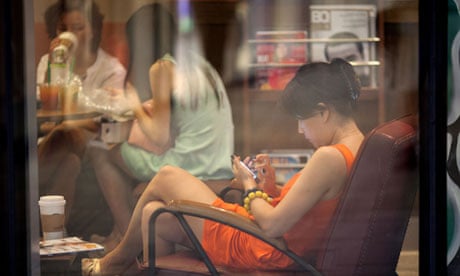This past Saturday, I did something radical: I put my phone away for 12 hours and spent an entire day in a new place with a small group of friends, walking around and chatting without texting, checking email, tweeting, updating Facebook, uploading photos to Instagram or otherwise engaging at all in the virtual world.
Is it a sad state of affairs when a day unplugged is an extreme deviation from my normal life? I'd imagine my parents, grandparents or less-connected peers might think so. But in reality, technology mostly makes my life better. Social media like Twitter and Instagram offer platforms to connect across barriers that would be insurmountable in "real" life. The political blogosphere is where I cut my teeth as a writer, forming friendships and professional relationships with other young journalists testing out what was then a new medium; I've watched as many of us have turned this blogging thing into real jobs, and proven ourselves as writers and thinkers.
Communication methods like g-chat, texting, email and Facebook have enabled me to stay in closer touch with friends near and far, and foster better relationships – I can see photos of a west coast friend's adorable baby; I'm reminded to wish people a happy birthday; I g-chat with a small handful of close friends all day long, and know the happenings in their lives in much greater detail than if we just met for a drink once a week, which adds many degrees of intimacy to the friendship. With every major invention and every breakthrough in technology and communication, nay-sayers have wrung their hands about the supposed destruction of genuine connections and authentic social bonds. Certainly any large-scale change to how we communicate is going to come with positives and negatives. But rather than put a screen between face-to-face interaction, I've found that technology and online media have not only helped to maintain my existing relationships, but have been vital in forming and fostering new ones.
At least most of the time. Sometimes, that screen does get in the way.
It gets in the way when I'm at dinner with a friend and she's only half-listening to what I'm saying because she's texting someone else. It gets in the way when I glance through an acquaintance's carefully-cultivated Tumblr and feel a twitch of envy at how obviously easy and flawless her life must be. It gets in the way when I'm watching a concert through my iPhone screen, focused more on the video quality than on the music. It gets in the way when I'm out socializing but distracted and then upset by my phone buzzing with dozens of @ replies from a Twitter argument. It gets in the way when I'm meeting someone new and the second conversation lulls, out comes the smartphone. It gets in the way when I'm exploring a new place and filtering what I'm seeing through the lens of what would look good on Instagram.
In a distraction-saturated world, I'm hardly the first to note how difficult it is to shut out the technological noise and simply be here. Which is how Saturday's phone-free day came about. My friend Baratunde Thurston, himself no stranger to over-connectedness and the need to get the hell off the internet for a while, invited me to participate in an "I Am Here" day with two other friends, Priya Parker and Anand Giridharadas. The rules: the day's cultivator picks one neighborhood in New York, researches it thoroughly and plans an itinerary. You meet at a designated location in the morning. Spend the day together. Keep the phone in your pocket.
"I Am Here" days were conceived by Priya and Anand on their honeymoon in Sri Lanka, in a conversation about how they wanted to live as a married couple as they transitioned from a life in Boston to one in New York. They decided to take weekends off of work and dedicate at least one day to exploring a new neighborhood; before they got started, a friend asked to join. Soon enough, the couples' weekend explorations were group activities. New friendships were forged. New York was soaked in.
I tagged along on the 14th excursion, and we went to Roosevelt Island – a neighborhood that, in my 12 years of living in New York, I've never visited. We learned that there's an incredibly diverse 800-foot-wide suburb complete with a single thoroughfare ("Main Street", naturally) sandwiched in the river between Manhattan and Queens. We listened to romantic advice from a Cameroonian mother and daughter. We flipped through the DVDs that island residents left at a local thrift store (standouts: Girls Gone Wild: Doggy Style; half a dozen Nollywood titles; the entire Disney princess collection on VHS). We had a picnic looking out onto Manhattan with a woman who grew up on the island and still lives there. We strolled past a group of men ranging in ages from mid-20s to mid-80s outside an assisted living facility, happily smoking marijuana in their wheelchairs. We spotted what appeared to be a gang of jetski riders speeding down the East River. We went on a manhunt with the Roosevelt Island police when my phone was accidentally stolen by a geriatric bar patron.
The day was absurd and funny and fun. And it was difficult, especially at first. My phone, I realized, is a social crutch. Everyone on the internet is an introvert, and I'm no exception. I socialize a lot, but sustained small-group conversation can feel exhausting; the need to be "on" when getting to know someone new is stressful and physically tiring. Stepping away to check email or refresh Twitter or send a SnapChat is an easy way to get a mental breather, the healthy addict's equivalent to stepping out for a cigarette. Without that escape hatch, any moments of silence or awkward points in the conversation were simply worked through. The concerted social effort put into the first few hours of the day – the initial politeness, the getting-to-know-you questions, the sussing out of the group's interests and conversational patterns and sense of humor and boundaries – eventually fell away, and a greater authenticity crept in.
As Priya says:
Spending 12 hours together with people is fundamentally different than spending three hours with people four different times. It's kind of the adult version of a sleepover.
There weren't pillow fights, but there was late afternoon crankiness. There were the nice introductions, and later, there were wildly inappropriate stories. There was the initial excitement of being in a new place, and then the visible stress when things went wrong.
"As professionals in our 30s in a city like New York, it's easy to just show one specific side of ourselves, as if we're perpetually reminded to think about branding," Priya says. "We try to present this clean exterior. I Am Here days challenge that, because when you spend a lot of time with a group of people – half the people we know, half we're meeting for the first time – it's really hard to 'control the message' for 12 hours. So it ends up being much more authentic and raw. You're letting go of control. And our Roosevelt Island day perfectly demonstrates that – you never know what might happen."
The intimacy fostered when you spend all day sharing one particular experience with a small group is indeed very different than a series of shorter meetings. There's also a heightened awareness that comes with experiencing a space without mentally filtering its aesthetic and without checking to see what everyone else is doing while you're there.
"One of the biggest fears of our generation is the fear of missing out. Missing out on the best way to spend an evening, the right job, the right move, even the right partner," Priya says. "The antidote to missing out is just being present, and being here, and committing to whatever you're doing, without wondering whether it's the absolute best way to spend your time."
The idea of being present isn't a new one. Many of my peers seem to be similarly seeking a way of reconnecting to the non-virtual world. We go on meditation retreats. We flock to yoga classes. What's tougher is figuring out how to be connected together. Priya and Anand's I Am Here model offers one easily-accessible option. If you want in, simply do it: get a small group, have one person set out a 12-hour itinerary for exploring a neighborhood, show up on time, put your phone away.
Fittingly, I would never have known about I Am Here days without the internet and social media: online political activism is how I met Baratunde, who introduced me to a third friend, who threw a dinner where I met Priya and Anand. We scheduled our I Am Here day over email. Priya researched places to go and things to do by googling, reading local blogs and checking Yelp reviews. I HopStopped my way to the Roosevelt Island tram. When my phone was lifted, we tracked its location through the Find My Phone function from both Baratunde's phone and his iPad.
We recovered the phone thanks to both technology and real-life human beings, who shared information and tracked down the older gentleman who mistakenly believed it belonged to a friend of his (my iPhone had the same black screen, body shape and Helvetica font as his friend's, he explained). We ended our night on the rooftop of an apartment building occupied by Salvatore, the manager of the bar where the phone was taken, drinking wine and looking at the Queensboro bridge from what was for me a new angle.
From Roosevelt Island, you can almost see the bridge's underbelly as it lights up the dark and leads over to the glowing Manhattan skyline. Salvatore's apartment is full of greenery, and in between enlightening us on the issues causing the most roiling Roosevelt Island blog fights, he told us about his favorite plant: the Cereus flower, a gift from his grandmother. It only blooms for a few hours once a year; its bud appears in the morning, the flower opens at night and by morning it's wilted. Our one day on Roosevelt Island was sadly not the night the plant chose to bloom. But the last time it did, Salvatore snapped some photos of the flower with his iPhone. He emailed us pictures.

